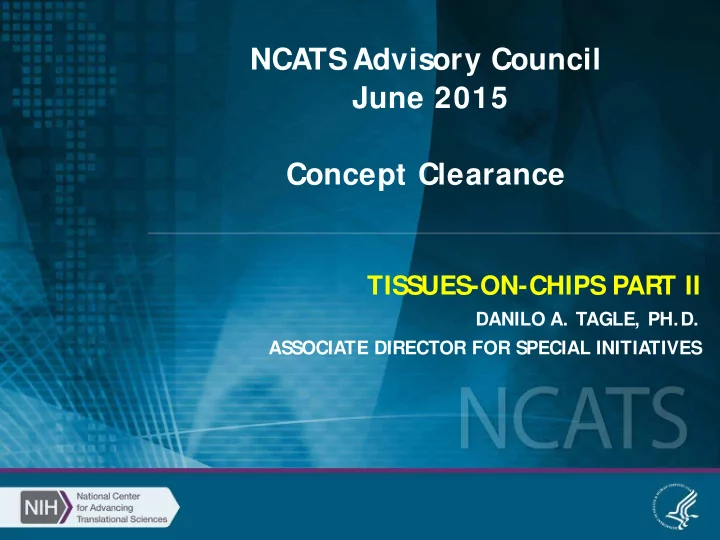

NCATS Advisory Council June 2015 Concept Clearance TISSUES-ON-CHIPS PART II DANILO A. TAGLE, PH.D. ASSOCIATE DIRECTOR FOR SPECIAL INITIATIVES
Tissues-on-Chips Part II Goal: To further develop and evolve tissues on chips technology to fully exploit its use as a pre-clinical tool but also as a clinical tool.
Tissues-on-Chips Part II Goal: To further develop and evolve tissues on chips technology to fully exploit its use as a pre-clinical tool but also as a clinical tool. Tissues on Chips I
Tissues-on-Chips Part II Goal: To further develop and evolve tissues on chips technology to fully exploit its use as a pre-clinical tool but also as a clinical tool. Tissues on Chips I Homunculus Homunculus – Organ representation in the current tissue chips are weak for endocrine, lymphatic and immune systems.
Tissues-on-Chips Part II Goal: To further develop and evolve tissues on chips technology to fully exploit its use as a pre-clinical tool but also as a clinical tool. Tissues on Chips I Homunculus Disease Modeling
Tissues-on-Chips Part II Goal: To further develop and evolve tissues on chips technology to fully exploit its use as a pre-clinical tool but also as a clinical tool. Disease modeling – Use of tissue chips to represent familial mutations derived from iPSCs of patients with rare diseases for studies on pathophysiology, customized therapy development and representation of the full spectrum of mutations for a rare disease even when the patient has passed. In addition, with the use of gene editing technologies, it is possible to introduce genetic polymorphisms on an isogenic iPSC line to dissect the contribution of genetics versus environment in human disorders. This approach can potentially also dissect the contribution of genetic polymorphisms as risk factors in polygenic diseases.
Tissues-on-Chips Part II Goal: To further develop and evolve tissues on chips technology to fully exploit its use as a pre-clinical tool but also as a clinical tool. Tissues on Chips I Homunculus Disease Modeling You on a Chip
Tissues-on-Chips Part II Goal: To further develop and evolve tissues on chips technology to fully exploit its use as a pre-clinical tool but also as a clinical tool. You-on-a-chip as part of Precision Medicine Initiative – Select iPSC lines from a subset of million person cohort from Precision Medicine Initiative used to seed human body-on-chips. Multiple, linked tissue mimics can act as test beds to stratify populations into drug responders and non-responders, examine multi-organ toxicities, study susceptibilities to environmental toxins, and explore the effect of the microbiome in human health and disease, at a scale not possible in studying the whole human in such large numbers.
Tissues-on-Chips Part II Goal: To further develop and evolve tissues on chips technology to fully exploit its use as a pre-clinical tool but also as a clinical tool. Tissues on Chips I Homunculus Clinical trials-on-chips Disease Modeling You on a Chip
Tissues-on-Chips Part II Goal: To further develop and evolve tissues on chips technology to fully exploit its use as a pre-clinical tool but also as a clinical tool. Clinical trials-on-chips –Develop human body-on chips from a number of well-characterized iPSC lines from a number of individuals representing the demographics of the general population. Specifically, tissue chips could inform the composition of a treatment cohort, or (given sufficient statistical power) even reduce the number of patients needed to show the desired effect.
Tissues-on-Chips Part II Brief description of the outcome • IMPORTANCE: At the end of the proposed next iteration of the tissue chip program, it is anticipated that the availability of these systems to the broader scientific community will foster a multitude of new research applications including, but not limited to studies in personalized medicine, environment exposures, reproduction and development, autoimmune disorders, infectious diseases, cancer, countermeasures for chemical warfare, immune responses and neuro-inflammation. • Criteria for evaluating success – cooperative agreements with well-defined annual milestones, and clear go/ no-go criteria • Maj or opportunity to address – building up on the success of tissues on chips part I • Relevance to the NCATS ’ mission - Re-engineering Translational S ciences by developing better Testing and Predictive Models • Ongoing research/ activity in this area - In the first part of this program, several unique and novel in vitro platforms have demonstrated human organotypic physiological functions and response to drug exposure ensuring that safe and effective therapeutics are identified sooner, and ineffective or toxic ones are rej ected early in the drug development process. These microfabricated devices have also proven to be useful for modeling human diseases and may prove to be sufficient alternatives to the use of animal testing.
Recommend
More recommend